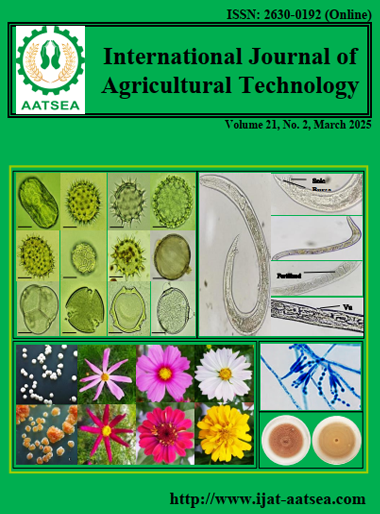Mycorrhizal mass multiplication in trap culture method in Cynodon sp. and evaluation of growth parameters
Main Article Content
Abstract
In the present study, one such method known as the trap culture method is utilized for the mass multiplication of mycorrhiza in Cynodon dactylon, and it is found to be successful for the mass production of the mycorrhizal spores. Mycorrhiza increased P and K in soil following application of mycorrhizal spore preparation. The mycorrhizal spores improved plant growth which was manifested by vigorous growth in treated plants. Biochemical analysis of twigs of C. dactylon revealed that protein content, reducing sugar, PAL content, and Chlorophyll content increased but total phenol and total sugar content reduced. Root colonization percentage, spore quantification, and soil health increased in the treated sets as compared to the controlled sets. Thus, mass multiplication of mycorrhiza in the trap culture method improved plant health as well as soil health in an eco-friendly manner.
Article Details

This work is licensed under a Creative Commons Attribution-NonCommercial-NoDerivatives 4.0 International License.
References
Babu, G. and Reddy, S. (2011). Influence of arbuscular mycorrhizal fungi on the growth and nutrient status of bermudagrass grown in alkaline bauxite processing residue. Environmental Pollution, 159:25-29.
Bago, B., Pfeffer, P. E. and Shachar-Hill, Y. (2000). Carbon metabolism and transport in arbuscular mycorrhizas. Plant Physiology, 124:949-958.
Chen, J., Zhang, H., Zhang, X. and Tang, M. (2027). Arbuscular mycorrhizal symbiosis alleviates salt stress in black locust through improved photosynthesis, water status, and K+/Na+ homeostasis. Frontiers in Plant Science, 8:1739.
Charest, C., Dalpe,´ Y. and Brown, A. (1993). The effect of vesicular arbuscular mycorrhizae and chilling on two hybrids of Zea mays L. Mycorrhiza, 4:89-92.
Clark, R. and Zeto, S. (2000). Mineral acquisition by arbuscular mycorrhizal plants. Journal of Plant Nutrition. 23: 867-902.
Cozzolino, V., Pigna, M., Di Meo, V., Caporale, A. G. and Violante, A. (2010). Effects of arbuscular mycorrhizal inoculation and phosphorus supply on the growth of Lactuca sativa L. and arsenic and phosphorus availability in an arsenic polluted soil undernon-sterile condition. Applied Soil Ecology, 45:262-268.
Finlay, R. and Soderstrom, B. (1992). Mycorrhiza and carbon flow in the soil. In: Mycorrhizal Functioning: An Integrated Plant Fungal Process (Eds.), M.F. Allen. Chapman and Hall, New York, London. pp.134-160.
Gerdemann, J. W. and Nicolson, T. H. (1963). Spores of mycorrhizal Endogone species extracted from soil by wet sieving and decanting. Trans. British Mycological Society, 46:235-244.
Gianinazzi, S. (1986). Progress and headaches in endomycorrhiza biotechnology. Symbiosi, 2:139-149.
Goussous, S. J. and Mohammad, M. J. (2009). Comparative Effect of Two Arbuscular Mycorrhizae and N and P Fertilizers on Growth and Nutrient Uptake of Onions. International Journal of Agriculture & Biology, 11:463-467.
Hawkes, C. V., Hartley, I. P., Ineson, P. and Fitter, A. H. (2008). Soil temperature affects carbon allocation within arbuscular mycorrhizal networks and carbon transport from plant to fungus. Global Change Biology, 14:1181-1190.
Jakobsen, I. and Rosendahl, L. (1990). Carbon flow into the external hyphae from roots of mycorrhizal cucumber plants. New Phytologist, 115:77-83.
Kullu, B. and Behera, N. (2016). A study of arbuscular mycorrhiza (AM) root colonization in the herbaceous vegetation of different age series sponge iron solid waste dumps. International Journal of Current Microbiology and Applied Sciences, 5:968-979.
Kyto¨viita, M. and Ruotsalainen, A. L. (2007). Mycorrhizal benefit in two low arctic herbs increases with increasing temperature. American Journal of Botany, 94:1309-1315.
Paradis, R., Dalpe,´ Y. and Charest, C. (1995). The combined effect of arbuscular mycorrhizas and short-term cold exposure on wheat. New Phytologist, 129:637-642.
Phillips, J. M. and Hayman, D. S. (1970). Improved procedures for clearing roots and staining parasitic and vesicular-arbuscular mycorrhizal fungi for rapid assessment of infection. Transactions of the British mycological Society, 55:158-161.
Sadasivam, S. and Manickam, A. (1992). Biochemical methods for agricultural sciences, Willey Eastern Ltd, New Delhi.
Sawers, R. J. H., Gutjahr, C. and Paszkowski, U. (2008). Cereal mycorrhiza: an ancient symbiosis in modern agriculture. Trends in Plant Science, 13:93-97.
Smith, S. E. and Read, D. J. (2010). Mycorrhizal symbiosis. Academic press.
Upreti, K. K., Bhatt, R. M., Panneerselvam, P. and Varalakshmi, L. R. (2016). Morpho-physiological responses of grape rootstock ‘Dogridge’ to arbuscular mycorrhizal fungi inoculation under sa¬linity stress. International Journal of Fruit Science, 16:191-209.
Vestberg, M. (1995). Occurrence of some Glomales in Finland. Mycorrhiza, 5:329-336.
Wang, B., Funakoshi, D. M., Dalpe´, Y. and Hamel, C. (2002). 32P absorption and translocation to host plants by AM fungi at low root zone temperature. Mycorrhiza, 12:93-96.
Wu, Q. S., He, X. H., Zou, Y. N., Liu, C. Y., Xiao, J. and Li, Y. (2012.) Arbuscular mycorrhizas alter root system architecture of Citrus tangerine through regulating metabolism of endogenous poly¬amines. Plant Growth Regulation, 68:27-35.
Wu, Q. S., Liu, C. Y., Zhang, D. J., Zou, Y. N., He, X. H. and Wu, Q. H. (2016). Mycorrhiza alters the profile of root hairs in trifoliate orange. Mycorrhiza, 26:237-247.


